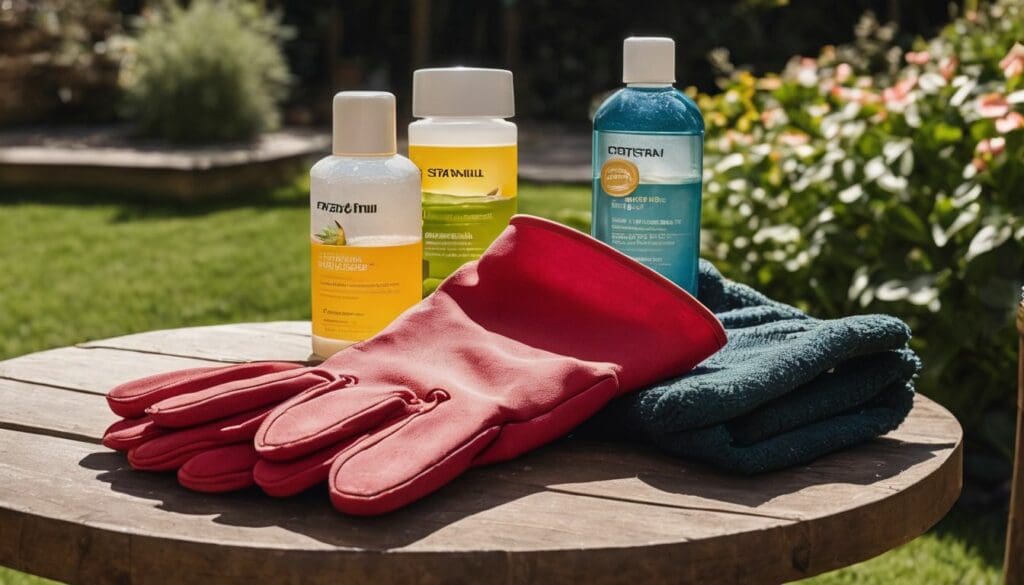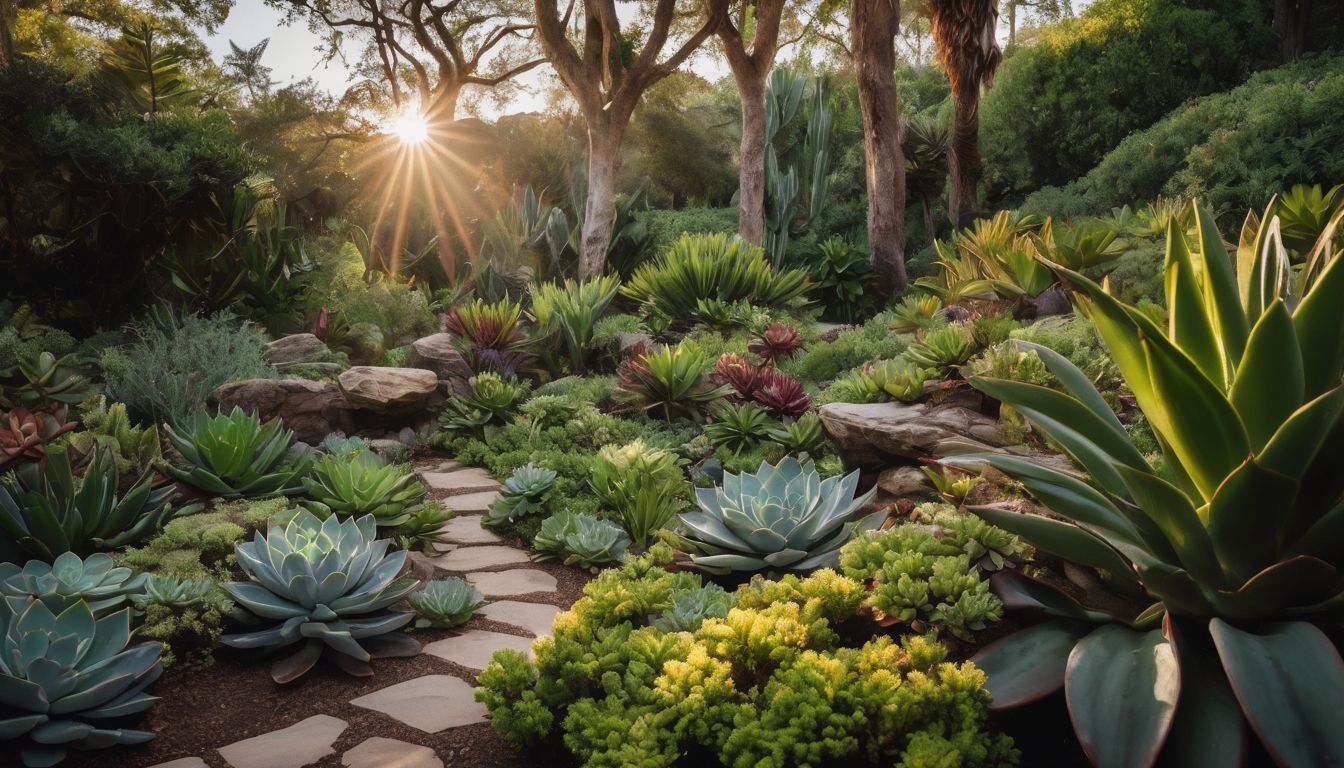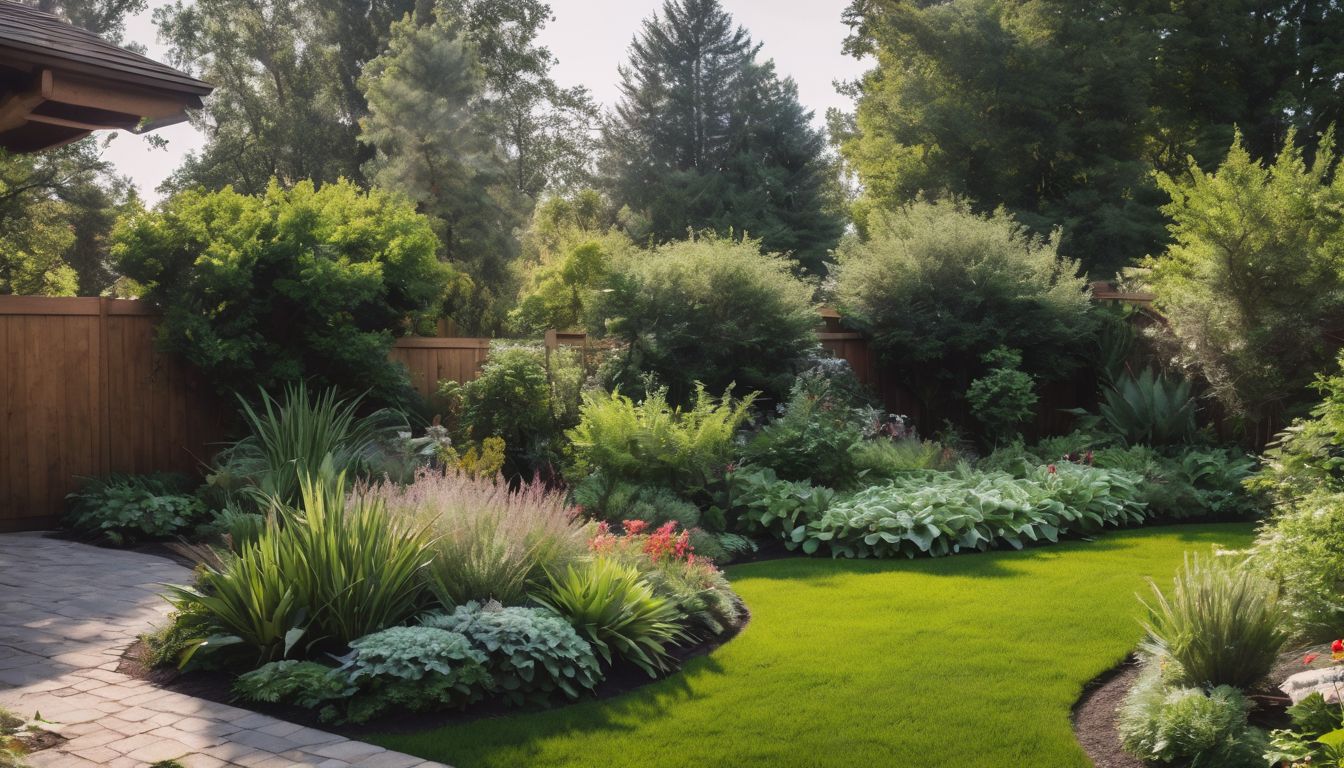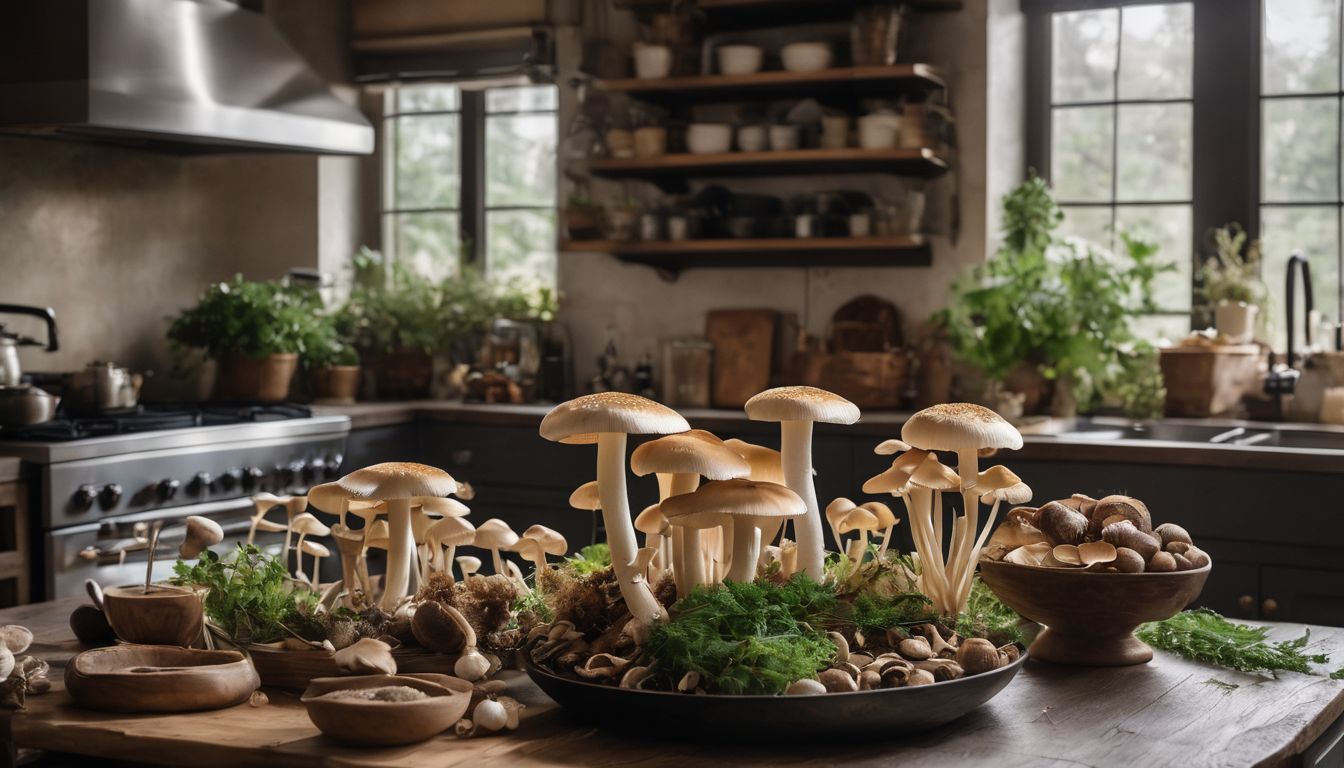Gardening brings joy, but it can also bring scrapes and sunburns. Every year, countless gardeners experience preventable injuries. Our guide unpacks essential safety tips to keep you blooming in health as your garden grows.
Stay safe and dig deep into this read!
Key Takeaways
- Always wear protective gear like gloves, long trousers and sleeves, and sunglasses or a hat to shield against garden injuries and harmful sun rays.
- Learn the correct techniques for lifting heavy objects in the garden, such as bending your knees and keeping loads close to reduce strain on your back.
- Take breaks frequently when gardening to prevent overexertion – vary tasks regularly, stay hydrated and seek shade especially during peak sunlight hours.
- Before starting garden work, do warm – up exercises to prime muscles and avoid injury; remember proper posture while using tools to keep you safe.
- Ensure children are closely supervised in the garden, teach them about hazards they may encounter, and provide them with appropriate-sized tools for their safety.
Understanding the Risks of Gardening
Gardening may seem like a peaceful and enjoyable activity, but it also comes with its own set of risks. From repetitive motions to overexertion and exposure to the sun, it’s important to be aware of potential hazards when working in the garden.
Repetitive motions
Repetitive motions in the garden, such as digging, planting or pruning can lead to strain and injury if not handled with care. Over time, these continuous movements might cause stress on muscles and joints.
It’s essential for gardeners to mix up their tasks and take regular breaks to prevent this kind of overuse injury.
To protect your body from strains associated with repetitive tasks, vary your activities throughout your gardening session. For instance, switch between kneeling to plant bulbs and standing to trim hedges.
This approach reduces the risk of putting too much pressure on any one part of your body and helps maintain a safe gardening environment for everyone involved.
Overexertion
Overworking your muscles in the garden can lead to fatigue and even injury. To avoid overexertion, pace yourself and take regular breaks. Stretching before and after gardening can also help prevent muscle strain.
Be mindful of how much weight you are lifting, using proper techniques to reduce strain on your body.
Limiting the time spent gardening is crucial in preventing overexertion. Consider breaking up tasks over several days rather than trying to complete everything at once. It’s important to listen to your body and recognise when it’s time to take a rest.
Sun exposure
To avoid overworking your body, it’s important to be mindful of sun exposure while gardening. Apply a generous amount of suncream before heading out, and remember to reapply throughout the day.
Take regular breaks in the shade to protect yourself from prolonged exposure. Stay hydrated by drinking plenty of water, especially on hot days. These simple precautions will help safeguard you against the harmful effects of excessive sun exposure.
After finishing up on this topic about “Sun Exposure” let me transition smoothly into “Use of tools and chemicals”.
Use of tools and chemicals
When managing the risks of gardening, it’s essential to handle tools and chemicals with care. Always wear protective gloves when using garden tools or handling chemicals to minimise skin contact.
Additionally, store all garden chemicals in a secure location, away from children and pets, to prevent accidental ingestion. Remember to always follow the manufacturer’s instructions for proper use and disposal of gardening chemicals to minimise environmental impact.
Moreover, ensure that all garden tools are maintained in good working condition and properly stored after use to prevent accidents. Regularly inspect your tools for signs of wear and tear, such as loose handles or dull blades, and promptly repair or replace them as necessary.
Protective Gear for Gardening
Wearing gloves, proper clothing (long trousers and sleeves), and sunglasses or a hat can protect you from potential hazards in the garden. To learn more about essential gardening safety tips, keep on reading!
Gloves
Gloves are essential for protecting your hands while gardening. They shield against cuts, scratches and irritation from plants or chemicals, helping you maintain safe handling of tools and materials.
Look for gloves made from durable, protective materials like leather or rubber to ensure a comfortable fit and reliable protection.
Opting for gloves with longer cuffs can provide additional coverage for your wrists and forearms, safeguarding them against potential injuries during gardening tasks. Make sure to always wear gloves when pruning thorny plants, handling pesticides or fertilisers, or working with soil to reduce the risk of skin irritation and exposure to harmful substances.
Proper clothing (long trousers and sleeves)
Wearing proper clothing such as long trousers and sleeves provides protection from potential scratches, insect bites, and exposure to harsh sunlight. This type of attire serves as a physical barrier against thorns, nettles, or poisonous plants that may be encountered while gardening.
Long-sleeved tops also safeguard the skin from inadvertent contact with irritating garden chemicals or fertilisers.
Long trousers and sleeves act as a crucial shield against various outdoor hazards in the garden environment. By wearing these garments, individuals can ensure that their skin is adequately protected while carrying out their gardening activities.
Sunglasses or a hat
Don’t underestimate the power of UV rays. Protect your eyes and skin from harmful sun exposure while gardening by wearing sunglasses or a hat. Not only will this shield you from potential long-term damage, but it will also make your time in the garden more comfortable and enjoyable.
Ensuring proper protection from the sun is crucial for maintaining health and safety in the garden. Now let’s explore “Proper Techniques for Safe Gardening” to further enhance your gardening practices.
Proper Techniques for Safe Gardening
To ensure safety while gardening, it’s important to warm up before starting, avoid repetitive motions, use proper lifting techniques and limit the amount of time spent working in the garden.
These techniques can help prevent strain and injury to your body while tending to your garden.
Warm-up exercises
Before starting your gardening session, warm-up exercises are crucial for preventing muscle strain and injury. Simple stretches for the arms, back, and legs will help loosen your muscles and prepare them for physical activity.
A brief walk around the garden can also get your blood flowing and increase flexibility. These warm-ups reduce the risk of strains when lifting heavy pots or tools, ensuring a safer gardening experience.
Engaging in warm-up exercises before tending to your garden is essential to prevent potential injuries from overexertion or repetitive movements. By incorporating these simple stretches into your routine, you can protect yourself against strains and enhance your overall safety while working outdoors.
Avoid repetitive motions
To prevent strain and injury, vary your gardening tasks frequently. Switch between activities like digging, weeding, and pruning to avoid overusing the same muscles for extended periods.
This reduces the risk of repetitive motion injuries and keeps your body balanced and healthy during your time in the garden.
When you’re done tackling repetitive motions, it’s important to also consider proper lifting techniques when handling heavy materials or equipment.
Proper lifting techniques
To prevent straining your back or causing injury, always bend your knees and keep your back straight when lifting heavy items such as bags of soil or pots. Keep the load close to your body while lifting and avoid twisting while carrying it.
When moving a heavy object, ask for help if needed; don’t hesitate to use a wheelbarrow or trolley for easier transportation.
When using garden tools, ensure that you use them with proper technique to avoid strain on muscles and joints. Use both hands evenly when possible, rather than straining one side of the body.
Limiting time spent gardening
Limit time spent gardening to prevent overexertion and repetitive motion injuries. Take regular breaks and listen to your body for signs of fatigue or strain. Staying mindful of the time spent engaged in gardening activities can help reduce the risk of muscle strains, back pain, and other common injuries associated with prolonged physical activity.
Avoid excessive sun exposure by limiting the duration of outdoor gardening sessions, especially during peak sunlight hours. Balancing the time spent working in the garden with periods of rest can protect against heat exhaustion and sunburn.
Remembering these guidelines will contribute towards a safer and more enjoyable gardening experience for both adults and children alike while supporting environmental conservation efforts.
Sun Safety in the Garden
Protect your skin from harmful UV rays by regularly applying sunscreen, taking breaks in the shade, and staying hydrated. To find out more about essential garden safety tips, keep reading!
Applying suncream
Apply sunscreen with a high SPF before heading out to the garden. Ensure that it offers broad-spectrum protection against UVA and UVB rays to safeguard your skin from sun damage. Remember to reapply every two hours for maximum effectiveness, especially if you’re sweating or working near water.
Choose a sunscreen that is safe for both your skin and the environment, opting for mineral-based options free of harmful chemicals. Consider wearing protective clothing like long sleeves and a wide-brimmed hat alongside using suncream for comprehensive sun protection in the garden.
Stay protected from harmful UV rays by regularly applying eco-friendly suncream during your gardening activities.
Taking breaks in the shade
After applying suncream, it’s important to take breaks in the shade. This practice helps prevent overheating and dehydration while working in the garden. Taking regular breaks allows the body to cool down and recover from exposure to the sun, reducing the risk of heat-related illnesses such as heatstroke or sunburn.
Gardening under a tree or an umbrella provides excellent natural shade that can offer protection from harmful UV rays. It also creates a comfortable environment for rest and rehydration during gardening sessions.
By incorporating these shaded breaks into your gardening routine, you can keep yourself safe from the potential risks of prolonged sun exposure mentioned earlier while enjoying your time tending to your garden.
Staying hydrated
Drink plenty of water while gardening, especially on hot days to prevent dehydration. Bring a reusable water bottle and take regular sips to stay hydrated. Consider adding natural flavourings like cucumber, lemon or mint to make drinking water more enjoyable.
Hydration is essential for maintaining energy levels and preventing heat-related illnesses during outdoor activities.
Remember that staying hydrated is crucial for your overall well-being and safety in the garden, so always keep a supply of water within easy reach. Next, let’s explore “Safety Tips for Gardening with Kids.”.
Safety Tips for Gardening with Kids
Teach kids about potential hazards in the garden and supervise them at all times. Provide child-sized tools to ensure their safety while gardening.
Teach them about potential hazards
Educating children about the potential hazards in the garden is crucial for their safety. Show them how to identify dangerous plants, tools, and chemicals. Encourage them to ask questions and seek help when unsure.
Knowing the risks empowers them to stay safe while exploring the natural world.
Ready to learn proper gardening techniques?
Supervise young children
After educating them about potential hazards, it’s important to supervise young children in the garden. Keep a close eye on them to ensure they are safe and not getting into any dangerous situations.
Providing child-sized tools will allow them to participate safely and learn about gardening without risking injury.
To guarantee their safety, always supervise when they’re around outdoor areas and teach them how to use tools responsibly. Remember that childproofing the garden is vital for preventing accidents while ensuring an enjoyable experience for all involved.
Provide them with child-sized tools
When gardening with kids, it is essential to provide them with child-sized tools. Child-sized tools are easier for children to handle and help reduce the risk of accidents or injuries.
By using these tools, kids can participate safely in garden activities, fostering a love for nature and sustainability from an early age.
Child-sized tools allow children to actively engage in gardening tasks while learning about plants and the environment. This hands-on experience helps them develop an appreciation for nature and encourages environmentally conscious practices as they grow older.
Conclusion
In conclusion, garden safety is essential for preventing injuries and ensuring an enjoyable gardening experience. By wearing protective gear, using proper techniques, and practising sun safety, you can reduce the risk of accidents.
When gardening with kids, it’s important to teach them about potential hazards and provide supervision. Remember, prioritising safety measures while gardening contributes to a happy and sustainable outdoor environment for all.
FAQs
1. What safety precautions should I take when gardening?
You should wear personal protective equipment, handle garden tools safely, and follow outdoor safety precautions to prevent accidents and injuries in the garden.
2. How can I ensure children’s safety in the garden?
To keep kids safe while they help with gardening, teach them safe handling of tools and provide supervision to practise injury prevention through careful activity.
3. Why is it important to use garden safety equipment?
Using the right garden safety equipment helps you protect yourself from potential hazards and reduces the risk of harm during garden maintenance activities.
4. What are some essential safe gardening practices everyone should know?
Essential safe gardening practices include learning how to properly use tools, wearing protective gear like gloves and boots, managing risks effectively, and keeping your workspace tidy to avoid accidents.
5. Can proper gardening safety measures help in preventing injuries for all ages?
Yes! Whether you’re an adult or a child, following robust safety measures such as using correct posture while lifting and carrying ensures accident prevention for every family member enjoying gardening tasks.





